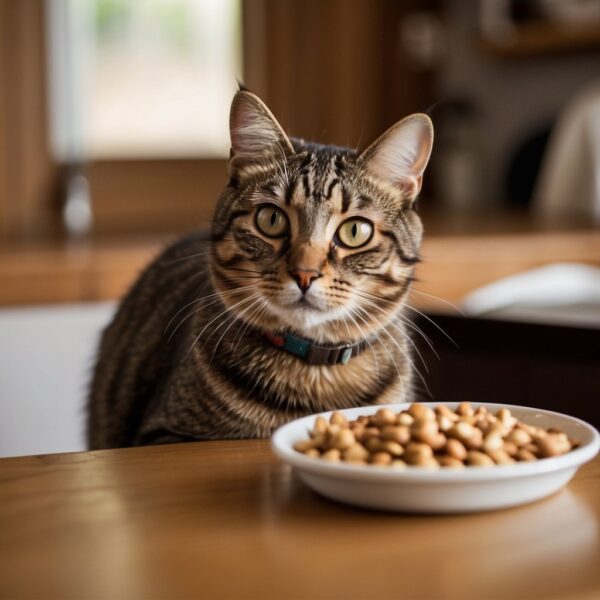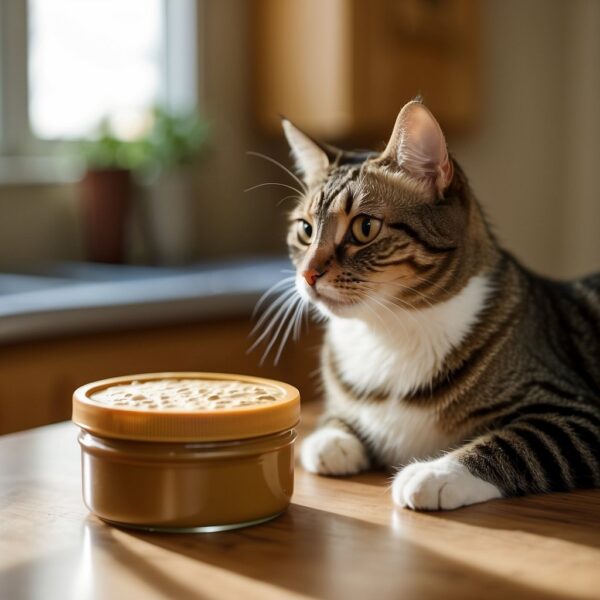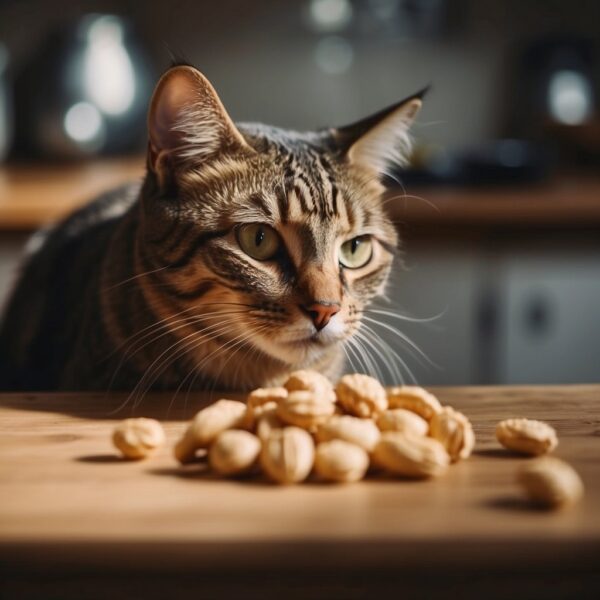
Is peanut butter safe for cats to eat
Peanut butter, a staple in many household pantries, often finds its way into the diets of family pets, with many dog owners using it as a treat or medication aid. However, can cats can eat peanut butter, this creamy delight, without adverse effects? Examining the issue from a feline health perspective is crucial, as cats have different nutritional requirements and metabolisms compared to dogs and humans. While most peanut butter is not immediately toxic to cats, several ingredients often present in peanut butter, such as artificial sweeteners like xylitol, can be harmful, if not fatal.
Feeding peanut butter to cats can introduce several health risks. Cats are obligate carnivores, which means they derive their nutrition primarily from meat. Their digestive systems are not adapted to process high-carbohydrate foods like peanut butter efficiently. Furthermore, peanut butter’s high fat content can lead to obesity and related diseases such as diabetes. It is also worth noting that peanut butter often contains additives, sugar, and salt, none of which offer any health benefit to a cat and can contribute to various health issues.
Key Takeaways
- Peanut butter is not recommended for cats due to potential health risks and the presence of harmful additives.
- Cats require diets tailored to their carnivorous nature, making peanut butter nutritionally inadequate.
- Alternative cat-safe treats should be considered to maintain a cat’s health and prevent possible complications.
Health Risks for Cats Consuming Peanut Butter
While peanut butter can be a nutritious treat for humans, it presents several health risks for cats. These risks include toxic substances, allergic reactions, digestive problems, and diet-related diseases.
Toxic Substances and Their Effects
Peanut butter may contain xylitol, a sugar substitute that is highly toxic to cats. Even small amounts of xylitol can cause liver failure and seizures in felines. Symptoms of xylitol poisoning in cats can escalate quickly and require immediate veterinary attention.
Common Allergic Reactions to Peanuts in Cats
Although not as common as in humans, cats can develop allergies to peanuts. Exposure to peanut proteins can cause allergic reactions manifested through vomiting, diarrhea, and skin issues. A visit to the veterinarian is advisable if an allergic reaction is suspected.
Digestive Issues and Food Intolerance
Cats lack the necessary enzymes to process certain components found in peanut butter. This can lead to gastrointestinal issues like upset stomachs and diarrhea. Overconsumption of peanut butter may exacerbate underlying food intolerances in some cats.
Weight and Diet-Related Diseases
Peanut butter is high in fats and hence, calories, which can contribute to weight gain and obesity in cats. Such weight issues are associated with a higher risk of diabetes and can place unnecessary strain on a cat’s heart, potentially causing heart issues over time. Cat owners should be cautious of the amount of peanut butter offered to their pets as treats, if any.

Hazards Related to cats eating Peanut Butter
While peanut butter is not a natural part of a cat’s diet, cat parents may consider it as an occasional treat. However, there are non-food risks tied to peanut butter of which cat parents must be aware.
Choking and Physical Hazards
Peanut butter’s sticky and thick texture poses a choking hazard to cats. The size of the treat matters significantly; thus, it is essential only to offer small amounts. Cats’ smaller throats are not designed to handle such viscous substances, and the risk of obstruction is real.
- Choking Hazard: Peanut butter’s consistency can cause it to stick to a cat’s mouth and throat.
Environmental Toxins and Contaminants
Aflatoxins, a type of mold found in the soil that can contaminate peanuts, may lead to cancer development in cats. The toxicity of these contaminants is a serious concern and underscores the importance of checking labels for any mention of aflatoxin-free guarantees when choosing peanut butter.
- Environmental Toxins: May include harmful substances like aflatoxins, which are carcinogenic.
- Outdoor Cats: Those that have access to peanut butter baits containing toxins may face additional risks.
Cat parents should be mindful of these hazards and consider safer, species-appropriate alternatives for their feline companions’ treats.
Nutritional Considerations for Cats
When considering peanut butter for cats, it’s essential to evaluate how its nutritional profile aligns with feline dietary needs and the potential risks it may pose.
The Feline Diet and Nutrient Requirements
Cats are obligate carnivores, which means their diet must be rich in proteins and certain amino acids that are typically found in meat. The essential nutrients that cats require include high-quality protein, taurine, certain fatty acids, vitamins, and minerals. Unlike dogs, which can survive on a more varied diet, cats have limited ability to digest carbohydrates.
Caloric and Fat Content in Peanut Butter
Peanut butter is calorie-dense, with a high fat content that can contribute to weight gain if fed in large quantities to cats. A small portion of peanut butter occasionally may not exceed a cat’s daily caloric intake significantly, but given that the average cat needs only about 200-300 calories per day, it’s important to moderate the serving size.
- Caloric content per tablespoon of peanut butter: approximately 94 calories
- Fat content per tablespoon of peanut butter: approximately 8 grams
Ingredients of Concern in Peanut Butter
Not all peanut butter is created equal, and some can be harmful to cats. Ingredients such as xylitol—an artificial sweetener found in some peanut butters—can be toxic to cats (and dogs). It’s also essential to look for peanut butter without excessive salt, sugar, or additional harmful additives.
- Toxic ingredients: Xylitol
- Harmful ingredients: Excessive salt, sugar, additives
Potential Health Benefits of Peanut Butter for Cats
While peanut butter does not offer any significant nutritional value to cats, it can occasionally serve as a treat or a vehicle for administering medication. Peanut butter contains protein and fat, which can provide a source of calories for a cat if needed. However, the potential health benefits do not outweigh the risks associated with feeding cats peanut butter as a regular part of their diet.

Safe Treat Alternatives and Practices
When considering treats for cats, it’s crucial to select options that are safe and nutritionally appropriate while ensuring they are given in proper portions to maintain the cat’s health.
Nutritionally Appropriate Cat Treats
Finding suitable treat alternatives for cats means choosing items that align with their nutritional needs. Cats are obligate carnivores, which implies their diet should primarily consist of high-quality protein. Safe treat choices include:
- Cooked Chicken: Unseasoned and finely diced for easy digestion.
- Tuna or Salmon: Offered sparingly due to high-fat content and potential for mercury exposure.
- Cat Food: Specially formulated treats or kibble, ensuring they meet AAFCO guidelines.
For those pet owners who prefer commercial options, vet-recommended treats that are designed specifically for cats should be the first choice as they ensure balanced nutrients that compliment a cat’s regular diet.
Homemade Cat Treat Recipes
Making treats at home allows cat parents to control the ingredients, ensuring their safety and healthiness. Some simple homemade treat options include:
- Cooked Eggs: Serve cooked eggs (boiled or scrambled) with no added oils or seasonings.
- Carrot and Pumpkin Puree: Small quantities of pureed carrots or pumpkin can add fiber to a cat’s diet.
- Fish Patties: Bake portions of fish combined with cat-friendly vegetables.
When preparing homemade treats, ensure that all ingredients are non-toxic to cats and avoid the use of garlic, onions, or seasonings which can be harmful.
Offering Treats in Moderation
Moderation is key when it comes to administering treats to maintain a cat’s optimal health and prevent obesity. Here are a few guidelines:
- Portion Size: Treats should make up no more than 10% of a cat’s daily caloric intake.
- Treats for Medication: For facilitating medication administration, use a small amount of a safe treat to conceal the pill.
- Frequency: Limit treats to avoid disrupting the nutritional balance of a cat’s main diet.
By keeping treat portions small and infrequent, cat owners can use treats effectively for training or bonding without compromising their cat’s nutrition.

Understanding Labels and Ingredients
When considering peanut butter as a treat for cats, understanding product labels and identifying specific ingredients is crucial for their health and safety.
How to Read Pet Food Labels
Pet food labels can be a wealth of information when one knows what to look for. At a minimum, pet food, including treats, should have a nutrition label that lists protein, fat, carbohydrates, and caloric content per serving. Look for products with high protein content and low levels of fats and carbohydrates, as these are closer to a cat’s natural dietary requirements.
Identifying Unsafe Ingredients
The ingredient list on a label should be scrutinized for potentially harmful components. Xylitol, an artificial sweetener often found in peanut butter, is toxic to cats. Other ingredients to avoid include high sodium, added sugars, and trans fats. It’s paramount to spot and steer clear of these ingredients:
- Xylitol: Can cause liver failure and hypoglycemia.
- High sodium: Can lead to dehydration and salt poisoning.
- Added sugars: Unnecessary and can lead to obesity.
- Trans fats: Harmful to cardiovascular health.
Recognizing Safe Treat Indicators
While most peanut butters are designed for human consumption, some can be safe for cats in moderation. Safe peanut butter will have no added sugar, xylitol, or high sodium. The simpler the ingredient list, the better. A safe ingredient list typically includes:
- Peanuts: Should be the primary ingredient.
- Salt: Only in trace amounts if at all.
When choosing treats, one should prioritize those specifically made for cats, as these are formulated to meet their nutritional needs and are less likely to contain unsafe ingredients.

Preventative Measures to keep your cat safe
When evaluating the potential inclusion of peanut butter in a cat’s diet, it’s crucial to weigh health benefits against risks. Peanut butter offers no significant nutritional value for cats and carries potential health hazards, such as choking risks and harmful additives. A cat’s dietary needs should be met with feline-specific foods recommended by professionals.
When to Consult a Veterinarian
If a cat exhibits unusual symptoms after consuming peanut butter, immediate veterinary consultation is imperative. These symptoms may include:
- Gastrointestinal distress
- Difficulty breathing
- Signs of an allergic reaction
Cats that accidentally ingest peanut butter containing xylitol should be taken to a veterinarian instantly, as xylitol toxicity requires urgent care. The American Society for the Prevention of Cruelty to Animals (ASPCA) places xylitol on its list of substances hazardous to pet health.
Preventing Exposure to Harmful Foods
Responsible cat guardianship involves safeguarding cats from foods that pose health risks. To prevent unintended exposure, parents should:
- Store peanut butter and other potentially harmful human foods out of reach.
- Educate all household members about the risks associated with feeding cats non-pet foods.
- Review pet food labels and ensure compliance with guidelines from reputable sources, like the ASPCA.
By adhering to these measures and being vigilant about a cat’s diet, pet parents can help ensure their feline companions maintain optimal health.
Frequently Asked Questions
These questions aim to address common concerns about feeding peanut butter to cats, covering safety, health impacts, and consumption guidelines.
Is peanut butter a safe food choice for cats?
Peanut butter is not inherently toxic to cats, but it is not an ideal food for them. Its high fat and protein content does not match a cat’s dietary needs, which favor a high-protein, low-carbohydrate diet.
Can cats eating peanut butter lead to health problems?
Yes, the consumption of peanut butter can lead to health issues such as obesity and pancreatitis in cats due to its high fat content. Additionally, peanut butter containing xylitol, an artificial sweetener, can be lethal.
What potential risks should I consider before giving my cat peanut butter?
Before giving peanut butter to a cat, consider the risk of additives such as xylitol, which is toxic to cats, and the potential for digestive upset due to its unnatural composition for a feline diet.
How does peanut butter affect a cat’s health?
Peanut butter can negatively affect a cat’s health by contributing to obesity, digestive issues, and possibly pancreatitis, given its high fat and sugar content.
Are there any benefits to a cat eating peanut butter?
There are no specific nutritional benefits for a cat eating peanut butter, and it should not replace a balanced feline diet.
In what quantity, if any, is peanut butter safe for cats to consume?
If given at all, peanut butter should only be offered to cats in very small amounts as an occasional treat, being mindful to avoid any products containing xylitol and considering the cat’s overall health and diet.